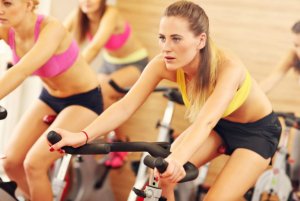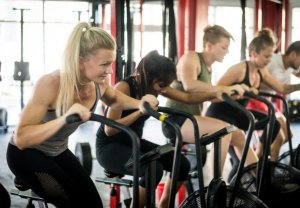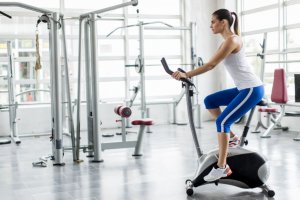What Muscles Are Targeted While Using a Stationary Bike?

When we use a stationary bike, either at home or in the gym, we are not only working out our cardiovascular system, but also several muscles. We’ll tell you what these are in the following article.
What muscles do we exercise with a stationary bike?
The static or stationary bike offers a good cardio workout and although the level of demand depends on us (and the weight and pedaling speed), the truth is, that this has a great impact on certain muscles.
One of the main benefits of riding a bicycle (including the stationary ones) is that our legs, buttocks and thighs are slimmed down, and our body as a whole, receives more oxygen.
If your plan is to increase your strength or build muscle using a bicycle, you should know that nothing is achieved overnight. Therefore, you will have to exercise at least three times each week.

The first results are only noticeable after the first month or month and a half. Although it’s believed that only the muscles in our lower body are worked with the bicycle, the truth is that the upper muscles must also make some effort:
-
Quadriceps
These muscles are located in the front of the thighs and are responsible for making most of the effort to pedal forward. This is the reason why the stationary bicycle is one of the best options to tone them.
-
Glutes
Even if we are in the saddle, we will also work this area of the body. However, in order to get better results, it’s important to switch between sitting and standing (as in spinning classes). The gluteus maximus and gluteus medius are the ones that will benefit the most from using the static bicycle.
-
Calves
Since the whole leg works during the exercise… indoor cycling also tones your calves! It doesn’t matter if we are sitting, standing or leaning forward. This part of our body tones up faster than any other.

Maybe it’s because calves usually have less fat than other parts of our body or that they make a good effort to pedal. Also, even if you don’t realize it, your calves are tensed throughout the whole work out.
-
Back
While it works to a lesser extent than the lower body muscles, the spine is also strengthened. When using a ‘common’ static bike it’s very important to maintain a good posture, with a straight back.
If we do spinning or indoor cycling we must pay more attention. The up and down movements on the saddle can make us bend our spine and suffer contractures or injuries.
-
Abs
By having a straight back and the correct posture, we can work the muscles of the abdomen when we ride a bicycle. No need to lie down with a mat at the end of the routine to do crunches!
-
Biceps and triceps
These muscles, located in the arms, are responsible for holding the handlebar and maintaining a correct posture. You will work them even more if you alternate the movements in the rest of your body (going up and down the saddle).
Here’s a trick: press your hands on the handlebar of the stationary bike to contract your biceps and triceps… It’s not weightlifting, but you will increase the work in that area.
Intensity and speed are fundamental to work our muscles when we use a static bicycle. While this exercise acts as strength and endurance training, it doesn’t always help to build muscle.
If you want to improve your results, you’ll have to avoid the typical ‘still pedaling’. Stop looking at your phone or watching the gym’s TV. You’ll have to combine sitting and standing cycles, add sprints (more speed), alternate resistance (weight) and keep your abs and glutes tight as you pedal.
When we use a stationary bike, either at home or in the gym, we are not only working out our cardiovascular system, but also several muscles. We’ll tell you what these are in the following article.
What muscles do we exercise with a stationary bike?
The static or stationary bike offers a good cardio workout and although the level of demand depends on us (and the weight and pedaling speed), the truth is, that this has a great impact on certain muscles.
One of the main benefits of riding a bicycle (including the stationary ones) is that our legs, buttocks and thighs are slimmed down, and our body as a whole, receives more oxygen.
If your plan is to increase your strength or build muscle using a bicycle, you should know that nothing is achieved overnight. Therefore, you will have to exercise at least three times each week.

The first results are only noticeable after the first month or month and a half. Although it’s believed that only the muscles in our lower body are worked with the bicycle, the truth is that the upper muscles must also make some effort:
-
Quadriceps
These muscles are located in the front of the thighs and are responsible for making most of the effort to pedal forward. This is the reason why the stationary bicycle is one of the best options to tone them.
-
Glutes
Even if we are in the saddle, we will also work this area of the body. However, in order to get better results, it’s important to switch between sitting and standing (as in spinning classes). The gluteus maximus and gluteus medius are the ones that will benefit the most from using the static bicycle.
-
Calves
Since the whole leg works during the exercise… indoor cycling also tones your calves! It doesn’t matter if we are sitting, standing or leaning forward. This part of our body tones up faster than any other.

Maybe it’s because calves usually have less fat than other parts of our body or that they make a good effort to pedal. Also, even if you don’t realize it, your calves are tensed throughout the whole work out.
-
Back
While it works to a lesser extent than the lower body muscles, the spine is also strengthened. When using a ‘common’ static bike it’s very important to maintain a good posture, with a straight back.
If we do spinning or indoor cycling we must pay more attention. The up and down movements on the saddle can make us bend our spine and suffer contractures or injuries.
-
Abs
By having a straight back and the correct posture, we can work the muscles of the abdomen when we ride a bicycle. No need to lie down with a mat at the end of the routine to do crunches!
-
Biceps and triceps
These muscles, located in the arms, are responsible for holding the handlebar and maintaining a correct posture. You will work them even more if you alternate the movements in the rest of your body (going up and down the saddle).
Here’s a trick: press your hands on the handlebar of the stationary bike to contract your biceps and triceps… It’s not weightlifting, but you will increase the work in that area.
Intensity and speed are fundamental to work our muscles when we use a static bicycle. While this exercise acts as strength and endurance training, it doesn’t always help to build muscle.
If you want to improve your results, you’ll have to avoid the typical ‘still pedaling’. Stop looking at your phone or watching the gym’s TV. You’ll have to combine sitting and standing cycles, add sprints (more speed), alternate resistance (weight) and keep your abs and glutes tight as you pedal.
This text is provided for informational purposes only and does not replace consultation with a professional. If in doubt, consult your specialist.








